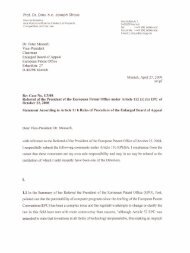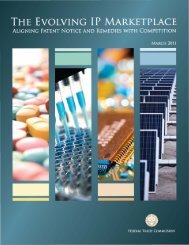<strong>Assessing</strong> <strong>the</strong> <strong>Obstacles</strong> <strong>to</strong><strong>Industrialisation</strong> : <strong>The</strong> MexicanEconomy, I 8 30-1 940*STEPHEN H. HABERAfter England began what came <strong>to</strong> be known as <strong>the</strong> First IndustrialRevolution at <strong>the</strong> end of <strong>the</strong> eighteenth century, industrial technologyquickly diffused throughout <strong>the</strong> nations of <strong>the</strong> North Atlantic. Withinfifty years of <strong>the</strong> first rumblings of British industrialisation, <strong>the</strong> fac<strong>to</strong>rysystem had spread <strong>to</strong> Western Europe and <strong>the</strong> United States. LatinAmerica, however, lagged behind. It was not until <strong>the</strong> twentieth centurythat manufacturing came <strong>to</strong> lead <strong>the</strong> economies of Latin America and thatagrarian societies were transformed in<strong>to</strong> industrial societies.This article seeks <strong>to</strong> understand this long lag in Latin Americanindustrialisation through an analysis of <strong>the</strong> experience of Mexico during<strong>the</strong> period 1830-1940 <strong>The</strong> purpose of <strong>the</strong> paper is <strong>to</strong> look at <strong>the</strong> obstaclesthat prevented self-sustaining industrialisation from taking place inMexico, as well as <strong>to</strong> assess <strong>the</strong> results of <strong>the</strong> industrialisation that didoccur.<strong>The</strong> basic argument advacced is that two different types of constraintsprevailed during different periods of Mexico's industrialisation. During<strong>the</strong> period from I 8 jo <strong>to</strong> I 8 80 <strong>the</strong> obstacles <strong>to</strong> industrialisation were largelyexternal <strong>to</strong> firms : insecure property rights, low per capita income growthresulting from pre-capitalist agricultural organisation, and <strong>the</strong> lack of anational market (caused by inefficient transport, banditry and internaltariffs) all served as a brake on Mexico's industrial development. During* Earlier versions of this article were presented at <strong>the</strong> 'K'hy <strong>the</strong> Lag in Latin AmericanIndustrialization?' conference at Harvard University, <strong>the</strong> Stanford University SocialScience His<strong>to</strong>ry Workshop, and <strong>the</strong> Conference of <strong>the</strong> California Intercampus Groupin Economic His<strong>to</strong>ry. Jeffrey L. Bortz, Frederick P. Bowser, Gregory Clark, John H.Coatsworth, Kenneth L. Sokoloff and John D. K'irth, as well as an anonymous referee,made detailed comments on earller drafts. Research for this article was funded bygrants from <strong>the</strong> Latin American Program of <strong>the</strong> Social Science Research Council and<strong>the</strong> Fulbright Program. <strong>The</strong> usual disclaimers apply.Stephen H. Haber is Associate Professor of His<strong>to</strong>ry at Stanford University/. Lot. Amrr \tun 24, I -3 r Pr~nfed in Greaf Britain
2 Stephen H. Hailer<strong>the</strong> period I 880-1 910 <strong>the</strong> obstacles <strong>to</strong> industrialisation were largelyinternal <strong>to</strong> firms. <strong>The</strong>se fac<strong>to</strong>rs included <strong>the</strong> inability <strong>to</strong> realise scaleeconomies, high fixed capital costs and low labour productivity. During<strong>the</strong> period from 1910 <strong>to</strong> 1930 <strong>the</strong>se internal constraints combined withnew external constraints - including <strong>the</strong> Revolution of I 9 I 0-1 7, <strong>the</strong>political uncertainty of <strong>the</strong> post-revolutionary period and <strong>the</strong> onset of <strong>the</strong>Great Depression - which fur<strong>the</strong>r slowed <strong>the</strong> rate of industrial growth.This article is organised in<strong>to</strong> three sections, each of which takes up oneof <strong>the</strong>se periods in detail. Each section begins with a discussion of <strong>the</strong>obstacles <strong>to</strong> industrial growth and <strong>the</strong>n assesses <strong>the</strong>ir impact on <strong>the</strong>structure and nature of manufacturing. <strong>The</strong> article ends with <strong>the</strong>rekindling of Mexican industrial growth in <strong>the</strong> mid- I 930s. <strong>The</strong> outcomesof that wave of growth, which stretched through <strong>the</strong> mid-197os, are notdiscussed in detail here, since that period has been written aboutextensively by o<strong>the</strong>r scholars.Mexico is chosen for study because, of all <strong>the</strong> countries of LatinAmerica, it was <strong>the</strong> most successful industrialiser prior <strong>to</strong> <strong>the</strong> Second\YTorld War. As early as <strong>the</strong> I 830s cot<strong>to</strong>n textile manufacturing in Mexicobegan <strong>to</strong> take place in a fac<strong>to</strong>ry setting and by <strong>the</strong> 1890s Mexico wasproducing a wide range of goods in large-scale, vertically integratedenterprises. In fact, many of Mexico's present-day industrial giants, someof which form <strong>the</strong> nuclei of large conglomerates, date from <strong>the</strong> end of <strong>the</strong>nineteenth century. Examples can be found in <strong>the</strong> steel, cement, glass,explosive, cigarette, soap, cot<strong>to</strong>n and wool textile, paper and beerindustries.Yet while industrial development began in Mexico quite early relative<strong>to</strong> <strong>the</strong> rest of Latin America, <strong>the</strong> process of self-sustaining industrialisationthat <strong>to</strong>ok hold in England or <strong>the</strong> United States did not occur. Instead, aseries of obstacles produced a truncated process of industrialisationdependent on government intervention, lacking in backward linkages <strong>to</strong>capital goods production, characterised by oligopoly and monopolyproduction, and dominated by entrepreneurs following rent-seekingstrategies.a-lssessing <strong>the</strong> obstacles <strong>to</strong> industrialisation, 1830-80In looking at <strong>the</strong> economic his<strong>to</strong>ry of Western Europe and <strong>the</strong> UnitedStates, scholars have pointed <strong>to</strong> a number of features of those economieswhich encouraged rapid rates of economic growth. Among <strong>the</strong> featurescommonly mentioned are <strong>the</strong> availability of low-cost transport, a relativelyeven distribution of income, highly productive agricultural sec<strong>to</strong>rs, lowentry costs for early manufacturers, and <strong>the</strong> development of legalinstitutions designed <strong>to</strong> protect property rights and facilitate commerce.In short, it is generally agreed that those economies which were already





